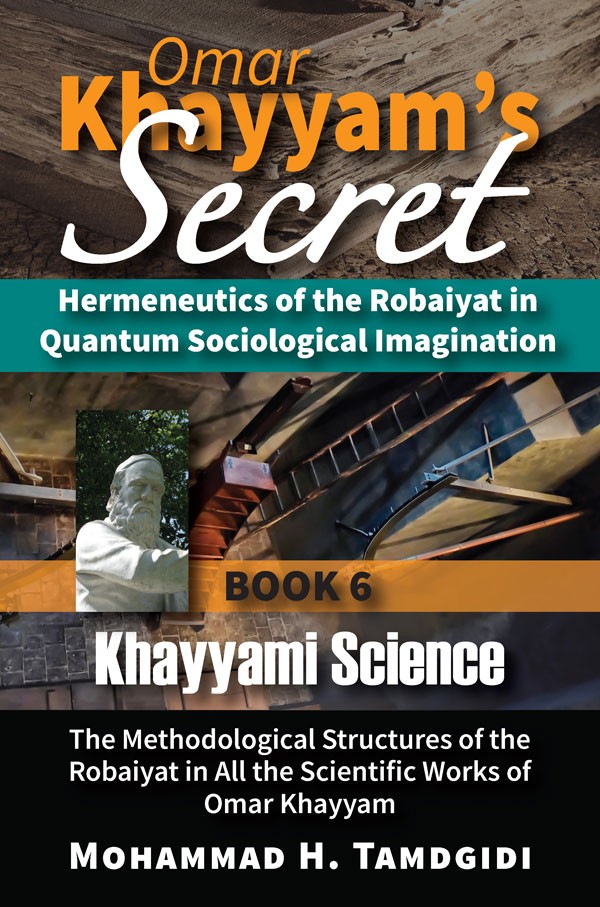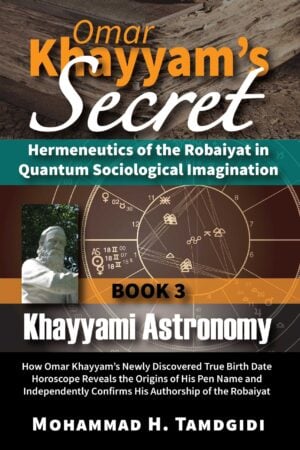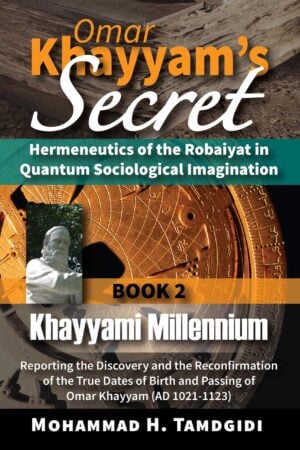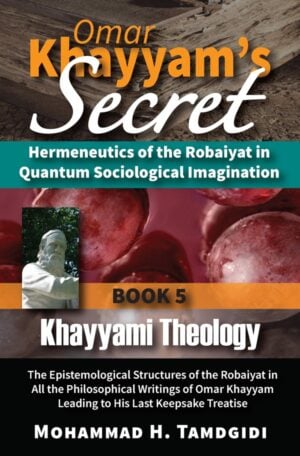Book Section: Preface and the Introduction to Book 6 of “Omar Khayyam’s Secret” Series: Exploring the Methodology of the Robaiyat in Omar Khayyam’s Scientific Works — by Mohammad H. Tamdgidi
$20.00
This book section includes the preface and and the introduction essays as described below. The essay titled “Book 6 Preface: Recap From Prior Books of the Series,” is an opening and the essay titled “Introduction to Book 6: Exploring the Methodology of the Robaiyat in Omar Khayyam’s Scientific Works” is an introduction to the book Khayyami Science: The Methodological Structures of the Robaiyat in All the Scientific Works of Omar Khayyam, which is the sixth volume of the twelve-book series Omar Khayyam’s Secret: Hermeneutics of the Robaiyat in Quantum Sociological Imagination, authored by Mohammad H. Tamdgidi.
Description
Abstract
This book section includes the preface and and the introduction essays as described below.
The essay titled “Book 6 Preface: Recap From Prior Books of the Series,” is an opening to the book Khayyami Science: The Methodological Structures of the Robaiyat in All the Scientific Works of Omar Khayyam, which is the sixth volume of the twelve-book series Omar Khayyam’s Secret: Hermeneutics of the Robaiyat in Quantum Sociological Imagination, authored by Mohammad H. Tamdgidi. It offers a summary of prior books of the series.
In the overall series, Tamdgidi shares the results of his research on Omar Khayyam, the enigmatic 11th/12th centuries Persian Muslim sage, philosopher, astronomer, mathematician, physician, writer, and poet from Neyshabour, Iran, whose life and works still remain behind a veil of deep mystery. The purpose of his research has been to find definitive answers to the many puzzles still surrounding Khayyam, especially regarding the existence, nature, and purpose of the Robaiyat in his life and works. To explore the questions posed in the series, he advances a new hermeneutic method of textual analysis, informed by what he calls the quantum sociological imagination, to gather and study all the attributed philosophical, religious, scientific, and literary writings of Khayyam.
In the first book of the series, subtitled New Khayyami Studies: Quantumizing the Newtonian Structures of C. Wright Mills’s Sociological Imagination for A New Hermeneutic Method, following a common preface and introduction to the series, Tamdgidi developed the quantum sociological imagination method framing his hermeneutic study in the series.
The second book of the series, subtitled Khayyami Millennium: Reporting the Discovery and the Reconfirmation of the True Dates of Birth and Passing of Omar Khayyam (AD 1021-1123), was dedicated to exploring in depth the hitherto findings and controversies surrounding the dates of birth and passing of Omar Khayyam. Therein, Tamdgidi discovered the true dates of birth and passing of Omar Khayyam.
The third book of the series, subtitled Khayyami Astronomy: How the Newly Discovered True Birth Horoscope of Omar Khayyam Reveals the Origins of His Pen Name and Independently Confirms His Authorship of the Robaiyat, was devoted to a close examination of Omar Khayyam’s newly discovered true birth date horoscope, and what information its hermeneutic study can offer for understanding Khayyam’s life and works, especially the origin, nature, and the purpose of his Robaiyat. Therein, Tamdgidi discovered the horoscope origins of Omar Khayyam’s pen name and independently confirmed his authorship of a collection of robaiyat.
The fourth book of the series was subtitled Khayyami Philosophy: The Ontological Structures of the Robaiyat in Omar Khayyam’s Last Written Keepsake Treatise on the Science of the Universals of Existence. It was devoted to an in-depth examination of Omar Khayyam’s treatise “Resaleh dar Elm-e Kolliyat-e Vojood” (Treatise on the Science of the Universals of Existence) which was written originally in Persian for keepsake toward the end of his life.
The fifth book of the series was subtitled Khayyami Theology: The Epistemological Structures of the Robaiyat in All the Philosophical Writings of Omar Khayyam Leading to His Last Keepsake Treatise. It was devoted to an in-depth examination of all of Omar Khayyam’s philosophical treatises written before his last keepsake treatise on the science of the universals of existence, one the author examined already in depth in Book 4 of the series. The purpose of the study of these texts, applying the quantum hermeneutic method developed for the series, was to arrive at an understanding of the structures of the theological epistemology informing any collection of quatrains or Robaiyat Khayyam may have written in his life.
The present, sixth book of the series, subtitled Khayyami Science: The Methodological Structures of the Robaiyat in All the Scientific Works of Omar Khayyam, is devoted to a hermeneutic study of all of Khayyam’s scientific works. The study is undertaken for the specific purpose of gaining hermeneutic insights into the methodological structures of Khayyam’s scientific thinking that can shed light on his literary works, especially his poetry writing.
The essay titled “Introduction to Book 6: Exploring the Methodology of the Robaiyat in Omar Khayyam’s Scientific Works,” is the introduction to book Khayyami Science: The Methodological Structures of the Robaiyat in All the Scientific Works of Omar Khayyam, which is the sixth volume of the twelve-book series Omar Khayyam’s Secret: Hermeneutics of the Robaiyat in Quantum Sociological Imagination, authored by Mohammad H. Tamdgidi.
As Tamdgidi had noted in the introduction to Book 5 of the series, it is important to keep in mind that in moving from the theme “Khayyami philosophy” in Book 4 to that of the Book 5 on “Khayyami theology” and in this Book 6 on “Khayyami science,” we are not moving away from one field of study to another across separate billiard balls, so to speak, as if we could mechanically separate these inquiries from one another, especially in the works of a premodern thinker such as Khayyam. Rather, the best way to consider the theme of this sixth book is that of further focusing Khayyam’s philosophical and theological worldview in applied form when addressing and practically solving specific scientific problems.
So, by moving from Khayyam’s philosophy to his theology and then (in the present volume) to his scientific works, we are not really moving away from the former two but further focusing them on dealing with specific scientific problems. Studying his scientific treatises allows us to gain a deeper insight into how Khayyam’s broader philosophical and theological worldview translates into methodological orientations and procedures in order to address and solve specific problems in applied theoretical and practical settings. By using the term “methodological” in this book, therefore, we mean to focus our understanding on how Khayyam’s ontological view of the world philosophically and his epistemological orientations to knowing it theologically translate into specific methods of practically addressing and solving scientific problems.
The extant texts from Khayyam that are studied in this book were all originally written in Arabic, given that it was at the time the universal language used in the philosophical and theological sciences in the broader Islamic world. To facilitate the reading and textual analyses of the texts for Persian speaking readers, alongside his new English translations of the texts offered before proceeding to analyze them, Tamdgidi will also provide their Persian translations. For the shorter two-part treatise on balance, he had to retranslate it anew into Persian, alongside which he will also provide for comparison a helpful partial translation done by an anonymous author from centuries past. Also for the shorter treatise on music, he had to correct some numbers in the original Arabic manuscript copy and also retranslate it into Persian since the original and existing Persian translations included verifiable errors in certain numbers given in the text. The errors can be verifiably corrected because the substance of what Khayyam discusses regarding the ratios comprising his evaluated tetrachord varieties provide a mathematically precise criterion on the basis of which the corrections can be safely made.
For the three other major treatises of Khayyam, the author will include the Persian translations by two late Khayyami scholars in Iran, Gholamhossein Mosaheb (1910-1979) and Jalaleddin Homaei (1900-1980), whose works have been used by other scholars in Iran and abroad when studying and translating the texts. He will provide references to their Persian translations in the respective chapters of this volume. This will also serve to provide Khayyami scholars for the first time with direct English translations of the Persian translations by Mosaheb and Homaei to compare with others’ or their own translations (to some of which I will also provide references in the respective chapters).
The treatises by Khayyam studied in this book include, in the order of the chapters devoted to them, a treatise on music, a two-part treatise on balance, a longer treatise about dividing a circle quadrant, a major treatise in algebra, and another major treatise on Euclid’s book Elements. For each text, Tamdgidi will first provide the Arabic text, followed by the Persian translation (by others or his own) and his new English translation of the text before proceeding to analyze it. The author notes that although he is not a specialist on the subject matter of any of the above extant texts by Khayyam, he tries to explain and show in respective chapters that one can gain significant hermeneutic understanding of Khayyam’s scientific method and orientations, even if one is not a specialist in their subject matter. Khayyam’s narrative is not purely technical; he also offers at times important autobiographical or other personal or contextual information about his work alongside technical materials. Tamdgidi’s aim in this volume is to study Khayyam’s text hermeneutically with the specific purpose in mind of understanding how Khayyam’s methodological approaches and orientations therein shed light on his writing poetry, such as his attributed Robaiyat.
Aside from texts, some of Khayyam’s works must be regarded as actually or possibly extant in non-literary forms, such as his reformed solar calendar currently practiced in Iran, or any influence he may have reportedly had on the design of the North Dome in the historic Masjed Jāmeʾ complex in Isfahan, Iran (the latter topic to be considered as part of a later volume of this series). The author will discuss in Chapter VI Khayyam’s astronomy (broadly considered, including any views he may have held about astrology and how these in turn could influence his poetic work) following the examination of the above-mentioned extant texts. The last chapter will also serve as a conduit for bringing together the findings of all the previous chapters and books in terms of how they shed light on Khayyam’s methodological orientations when pursuing his poetry writing.
Reminding his readers in the introduction about the framework of quantum sociological imagination in which this series research is being conducted, Tamdgidi notes that in the series he adopts an alternative research procedure whereby Khayyam’s views are in the first half of the series derived not directly from the disputed Robaiyat to explain them in turn following a circular logic of reasoning, but by way of a procedure based on careful examinations of Khayyam’s primary and undisputed writings as an alternative pathway toward understanding the origins, nature, and purpose of any poetry he may have composed.
The author ends the introduction by presenting the chapter organization of this book.
Recommended Citation
Tamdgidi, Mohammad H. 2023. “Preface and the Introduction to Book 6 of “Omar Khayyam’s Secret” Series: Exploring the Methodology of the Robaiyat in Omar Khayyam’s Scientific Works.” Pp. 1-18 in Omar Khayyam’s Secret: Hermeneutics of the Robaiyat in Quantum Sociological Imagination: Book 6: Khayyami Science: The Methodological Structures of the Robaiyat in All the Scientific Works of Omar Khayyam. (Human Architecture: Journal of the Sociology of Self-Knowledge: Vol. XIX, 2023. Tayyebeh Series in East-West Research and Translation.) Belmont, MA: Okcir Press.
Where to Purchase Complete Book: The various editions of the volume of which this Book Section is a part can be ordered from the Okcir Store and all major online bookstores worldwide (such as Amazon, Barnes&Noble, Google Play, and others).
Read the Above Publication Online
To read the above publication online, you need to be logged in as an OKCIR Library member with a valid access. In that case just click on the large PDF icon below to access the publication. Make sure you refresh your browser page after logging in.








